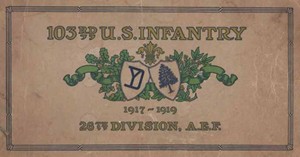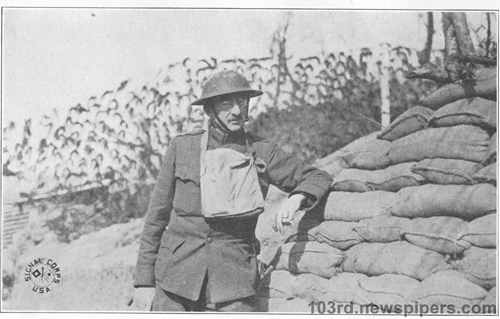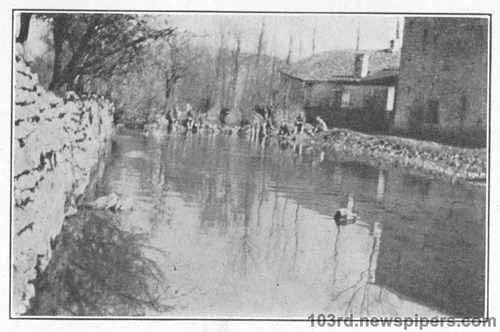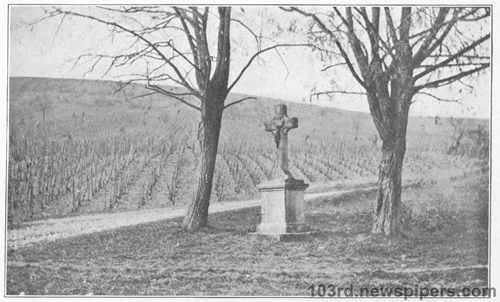
of the 26th Division of the U.S. Army
during World War I
 | The History of the 103rd Regiment of the 26th Division of the U.S. Army during World War I |
| Table of Contents | |||||||||||||||||||||||||||||
 left. It must be remembered that this first tour of cluty was primarily for thc
purpose of instruction. The regiment went in Februaury 8, and was relieved
March 19.
left. It must be remembered that this first tour of cluty was primarily for thc
purpose of instruction. The regiment went in Februaury 8, and was relieved
March 19.
The following ehnrt gives the tour as taken by (lic regiment: TOUR or lsr BAT'l`ALI(>X
Toon or 2xu B.».·1··1·Ai.1ox
Town <>1= 3RD BA'l"I`Al.l()N

Regimental Headquarters was at Vauxdesson; headquarters of support battal- ion, at cave; of reserve, at Vregny; of front line, at Bareelonette. Before speaking of the particular work attached to eaeh position a few further general observations should be made. After the French had successfully retaken the ground from Pinon Forest on the left to the Chemin des Darnes on thc right, apparently no very serious attempt was made to organize the front for the resist— ance of an attack of any magnitude. Reliance was placed on the secondary or resisting line, and that was why from the support (from St. Blaise) to the front, the general impression was of a series of defenses against which an attack was bound to be piled up, a sort of tremendous spring system which could be and might be pushed back, but in the end was bound to recoil. Another name for recoil might be said to be "eounter attaek." Perhaps it was with a sense of dis- appointment that the front line was found to be only a series of outposts, each . a little strong point in itself, manned only with a sentry or two on duty in the day- time, a squad to a half platoon at night. "Petites postes " they were called, from Fifty to two hundred yards apart, hut cleverly located and earnouflaged, covering the approaches to er through o1n· lines. This was not quite the kind of a front one reads about, but, for all that there was not a complete front-li.ne trench system, much was lcarned,~the neeossityof concealment, for good liaison between posts, platoons, and companies; for silence, valuable experience in patrolling; the taking care of health, sanitation, care of equipment, making reliefs, sketches, reports, getting up supplies; proper feeding offmen, —— all things which officers and men should be familiar with if they are going to make real soldiers, ifront-line men. And last, but not least, was the getting familiar with artillery and machine-gun Fire, both our own and the enemy' s. Nur was instruction and information gained limited to the tour in the front line; in reserve and support, working parties were out day and night; in support these parties used to leave the cave before daylight and then, if visibility was too clear, returned by nine or ten o'cloek in small groups. In reserve drill was carried on; also work on reserve position, digging trcnehm, stringing wire, etc. This eould he done, however, in daytime. In comparison with sectors later occupied, this was a quiet front; casualties were slight. Lieutenant Harold Eadie and four men were killed by shell fire and afew men wounded. On March 6 and 7 the enemy tried out a little gas on the sector, but with no success. March 12 Captain Hosford took command of the 2nd Battalion, Major Mayo having been assigned other duty, Lieutenant Doane taking command of CompanyL. As a matter of fact, the men were gladwhen this First tour of duty ended, for it had been a considerably longer one than antici- pated, and it was with a good deal of satisfaction that they entrained supposedly to return to Liffol for a rest, cleaning up, and further instruction. The entire division was to move back to its old Vosges area. Detraining at Bar-sur-Aube, the battalions marched out in order of arrival to the small villages nearby where they were well received and comfortably billeted. The country thcrcabouts was very attractive——rich fields, vineyard-covered hills, pr0sper0us·looking farms. It was the beginning of spring and there followed a perfect week for the hike hack to Liffol. The route of march led northeast through Blaise, Bologne, St. Blin —- about a seventy-live-kilometer march. The regiment moved as a unit and this, its first long march in France, ran smoothly. 
|
|||||||||||||||||||||||||||||
| Original Version of Page |